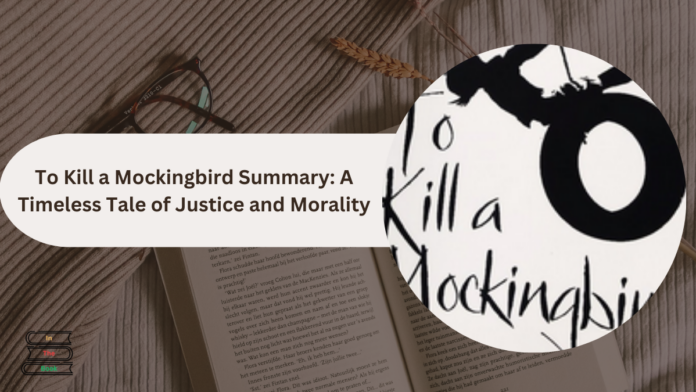To Kill a Mockingbird, summary provides an in-depth look at Harper Lee’s classic novel, which delves into issues of racial injustice, tolerance, and the loss of innocence in a small Alabama town during the 1930s. Told through the eyes of young Scout Finch, the story centres around her father, Atticus Finch, and his defence of a wrongly accused black man, Tom Robinson, in a profoundly prejudiced community. This To Kill a Mockingbird summary highlights this enduring literary work’s key elements and themes.
Contents
- To Kill a Mockingbird Summary: A Journey of Self-Discovery
- The Trial of Tom Robinson
- The Character of Atticus Finch
- The Theme of Childhood Innocence
- The Role of Boo Radley
- The Impact of Racism and Social Inequality
- The Importance of Moral Courage
- The Influence of Family and Community
- Lessons of Empathy and Understanding
- Conclusion
To Kill a Mockingbird Summary: A Journey of Self-Discovery
As Scout Finch navigates her childhood, she learns valuable lessons about justice, empathy, and understanding from her father, Atticus, who is determined to prove Tom Robinson’s innocence despite the prejudice and hostility he faces. Scout and her older brother, Jem, become fascinated with their reclusive neighbour, Boo Radley, who is the subject of local legend and rumours. Through these experiences, Scout begins questioning the societal norms and prejudices surrounding her, embarking on a journey of self-discovery and moral growth.
The Trial of Tom Robinson
Tom Robinson’s trial is pivotal in To Kill a Mockingbird. Atticus Finch, representing Robinson, delivers a powerful defence that highlights the inconsistencies and biases in the prosecution’s case. Despite his compelling arguments, the all-white jury convicts Robinson, a decision met with widespread approval from the white community. This outcome is a devastating blow to Atticus, Scout, and Jem, forcing them to confront the harsh realities of racial injustice in their society.
The Character of Atticus Finch
In To Kill a Mockingbird, Atticus Finch symbolizes moral integrity and justice. His defence of Tom Robinson is driven by a strong sense of duty and a commitment to doing what is right, even in the face of overwhelming opposition. Through Atticus, Harper Lee explores the importance of empathy, compassion, and understanding in breaking down social barriers and challenging deeply ingrained prejudices.
The Theme of Childhood Innocence
The theme of childhood innocence is central to To Kill a Mockingbird. Scout and Jem’s experiences force them to navigate the complexities of adulthood, confronting the stark realities of racial injustice and prejudice. Through their journey, Lee underscores preserving childhood innocence while promoting empathy and understanding. The loss of innocence experienced by Scout and Jem serves as a poignant reminder of the impact of societal injustices on young minds.
The Role of Boo Radley
Boo Radley, the mysterious neighbour, plays a significant role in Scout and Jem’s understanding of bravery and compassion. Initially perceived as a frightening figure, Boo ultimately reveals his kindness by protecting Scout and Jem from danger. This transformation in their perception of Boo highlights the novel’s message about the dangers of judging others based on rumours and appearances.
The Impact of Racism and Social Inequality
To Kill a Mockingbird critically examines racism and social inequality. Through Tom Robinson’s trial and the characters’ interactions, Lee exposes the deep-seated racial prejudices that permeate the town of Maycomb. The novel challenges readers to reflect on their beliefs and the societal structures perpetuating discrimination.
The Importance of Moral Courage
Moral courage is a recurring theme in To Kill a Mockingbird. Atticus Finch embodies this trait as he stands up for justice and equality despite facing social ostracism and personal danger. His unwavering commitment to his principles inspires Scout and Jem, teaching them the value of standing up for what is right.
The Influence of Family and Community
Family and community are crucial in shaping the characters’ values and beliefs. The Finch family, particularly Atticus, serves as a moral compass for Scout and Jem. The community of Maycomb, with its various attitudes and behaviours, provides a backdrop against which the novel’s themes are explored. The contrasting influences of family and community highlight the complexities of moral development and social conformity.
Lessons of Empathy and Understanding
Empathy and understanding are central lessons in To Kill a Mockingbird. Atticus teaches Scout and Jem to consider things from others’ perspectives, famously advising Scout to “climb into [someone’s] skin and walk around in it.” This lesson is exemplified through the children’s evolving perception of Boo Radley and their understanding of the systemic injustices faced by Tom Robinson.
Conclusion
In conclusion, To Kill a Mockingbird summary encapsulates a timeless tale of justice, morality, and the loss of innocence. Through Scout’s journey, Harper Lee explores profound issues of racial injustice, tolerance, and empathy, creating a powerful and thought-provoking novel that continues to resonate with readers today. The themes and characters of To Kill a Mockingbird offer enduring lessons about humanity and the importance of standing up for what is right, making it a classic work of American literature.
Click Here To Read More

Ross, an exam specialist with a passion for education, writes comprehensive articles on exam results and admit cards. His expertise ensures students receive reliable information and useful tips to excel in their exams.



























